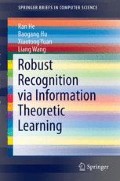Abstract
Nonnegativity constraint is more consistent with the biological modeling of visual data and often leads to better performance for data representation and graph learning [66]. In this chapter, we present an overview of some recent advances in correntropy with nonnegative constraint. We begin with an introduction of an ℓ 1 regularized nonnegative sparse coding algorithm to learn a nonnegative sparse representation (NSR). Then we show how to use correntropy to learn a robust NSR. Finally, based on the divide and conquer strategy, a two-stage framework is discussed for large-scale sparse representation problems.
Access this chapter
Tax calculation will be finalised at checkout
Purchases are for personal use only
Notes
- 1.
Since β is assumed to be sparse, LCP can be used to efficiently find a sparse active set.
- 2.
According to Theorem 4.2, we can learn that p ≤ 0. By replacing the p with − p, we can get the equivalent minimal problem.
- 3.
- 4.
Subspace U is composed of the eigenvectors computed by principal component analysis [49].
- 5.
- 6.
The source code: http://www.acm.caltech.edu/l1magic/.
- 7.
The source code: http://redwood.berkeley.edu/bruno/sparsenet/.
- 8.
- 9.
The source code: http://www.openpr.org.cn/index.php/All/69-CESR/View-details.html.
- 10.
The source code: http://www4.comp.polyu.edu.hk/~cslzhang.
References
Bjorck, A.: A direct method for sparse least-squares problems with lower and upper bounds, numer. Math 54, 19–32 (1988)
Black, M., Jepson, A.: Eigentracking: Robust matching and tracking of articulated objects using a view-based representation. International Journal of Computer Vision 26(1), 63–84 (1998)
Bruckstein, A.M., Elad, M., Zibulevskyy, M.: On the uniqueness of nonnegative sparse solutions to underdetermined systems of equations. IEEE Transactions on Information Theory 54(11), 4813–4820 (2008)
Candés, E.J., Romberg, J.: l1-magic: recovery of sparse signals via convex programming. http://www.acm.caltech.edu/l1magic/ (2005)
Donoho, D.L., Tanner, J.: Sparse nonnegative solutions of underdetermined linear equations by linear programming. In: Proceedings of the National Academy of Sciences, vol. 102, pp. 9446–9451 (2005)
Fidler, S., Skocaj, D., Leonardis, A.: Combining reconstructive and discriminative subspace methods for robust classification and regression by subsampling. IEEE Transactions on Pattern Analysis and Machine Intelligence 28(3), 337–350 (2006)
Gao, W., Cao, B., Shan, S., Chen, X., Zhou, D., Zhang, X., Zhao, D.: The cas-peal large-scale Chinese face database and baseline evaluations. IEEE Transactions on System Man, and Cybernetics (Part A) 38(1), 149–161 (2008)
He, R., Hu, B.G., Yuan, X.: Robust discriminant analysis based on nonparametric maximum entropy. In: Asian Conference on Machine Learning (2009)
He, R., Hu, B.G., Zheng, W.S., Guo, Y.Q.: Two-stage sparse representation for robust recognition on large-scale database. In: AAAI Conference on Artificial Intelligence, pp. 475–480 (2010)
He, R., Zheng, W.S., Hu, B.G.: Maximum correntropy criterion for robust face recognition. IEEE Transactions on Pattern Analysis and Machine Intelligence 33(8), 1561–1576 (2011)
He, R., Zheng, W.S., Hu, B.G., Kong, X.W.: Nonnegative sparse coding for discriminative semi-supervised learning. In: IEEE Conference on Computer Vision and Pattern Recognition, pp. 2849–2856 (2011)
He, R., Zheng, W.S., Hu, B.G., Kong, X.W.: Two-stage nonnegative sparse representation for large-scale face recognition. IEEE Transactions on Neural Network and Learning System 34(1), 35–46 (2013)
Ji, Y., Lin, T., Zha, H.: Mahalanobis distance based non-negative sparse representation for face recognition. In: Proceedings of International Conference on Machine Learning and Applications, pp. 41–46 (2009)
Lee, H., Battle, A., Raina, R., Ng, A.Y.: Efficient sparse coding algorithms. In: Proceedings of Neural Information Processing Systems, vol. 19, pp. 801–808 (2006)
Lei, Z., Chu, R., He, R., Liao, S., Li, S.Z.: Face recognition by discriminant analysis with Gabor tensor representation. In: Advances in Biometrics (2010)
Liu, R., Li, S.Z., Yuan, X., He, R.: Online determination of track loss using template inverse matching. In: International Workshop on Visual Surveillance-VS (2008)
Liu, W.F., Pokharel, P.P., Principe, J.C.: Correntropy: Properties and applications in non-gaussian signal processing. IEEE Transactions on Signal Processing 55(11), 5286–5298 (2007)
Martinez, A.M., Benavente, R.: The AR face database. Tech. rep., Computer Vision Center (1998)
Naseem, I., Togneri, R., Bennamoun, M.: Linear regression for face recognition. IEEE Transactions on Pattern Analysis and Machine Intelligence 32(11), 2106–2112 (2010)
Nikolova, M., NG, M.K.: Analysis of half-quadratic minimization methods for signal and image recovery. SIAM Journal on Scientific Computing 27(3), 937–966 (2005)
Portugal, L.F., Judice, J.J., Vicente, L.N.: A comparison of block pivoting and interior-point algorithms for linear least squares problems with nonnegative variables. Mathematics of Computation 63(208), 625–643 (1994)
Vo, N., Moran, B., Challa, S.: Nonnegative-least-square classifier for face recognition. In: Proceedings of International Symposium on Neural Networks:Advances in Neural Networks, pp. 449–456 (2009)
Wright, J., Yang, A.Y., Ganesh, A., Sastry, S.S., Ma, Y.: Robust face recognition via sparse representation. IEEE Transactions on Pattern Analysis and Machine Intelligence 31(2), 210–227 (2009)
Xing, E.P., Ng, A.Y., Jordan, M.I., Russell, S.: Distance metric learning with application to clustering with side-information. In: Proceedings of Advances in Neural Information Processing Systems, vol. 15, pp. 505–512 (2002)
Yang, M., Zhang, L., Yang, J., Zhang, D.: Robust sparse coding for face recognition. In: Proceedings of IEEE Conference on Computer Vision and Pattern Recognition, pp. 625–632 (2011)
Yang, S., Zha, H., Zhou, S., Hu, B.G.: Variational graph embedding for globally and locally consistent feature extraction. In: Europe Conference on Machine Learning (ECML), pp. 538–553 (2009)
Yuan, X.T., Hu, B.G.: Robust feature extraction via information theoretic learning. In: Proceedings of International Conference on Machine Learning, pp. 1193–1200 (2009)
Zhang, L., Yang, M., Feng, X.: Sparse representation or collaborative representation: Which helps face recognition? In: Proceedings of IEEE International Conference on Computer Vision (2011)
Author information
Authors and Affiliations
Rights and permissions
Copyright information
© 2014 The Author(s)
About this chapter
Cite this chapter
He, R., Hu, B., Yuan, X., Wang, L. (2014). Correntropy with Nonnegative Constraint. In: Robust Recognition via Information Theoretic Learning. SpringerBriefs in Computer Science. Springer, Cham. https://doi.org/10.1007/978-3-319-07416-0_6
Download citation
DOI: https://doi.org/10.1007/978-3-319-07416-0_6
Published:
Publisher Name: Springer, Cham
Print ISBN: 978-3-319-07415-3
Online ISBN: 978-3-319-07416-0
eBook Packages: Computer ScienceComputer Science (R0)

